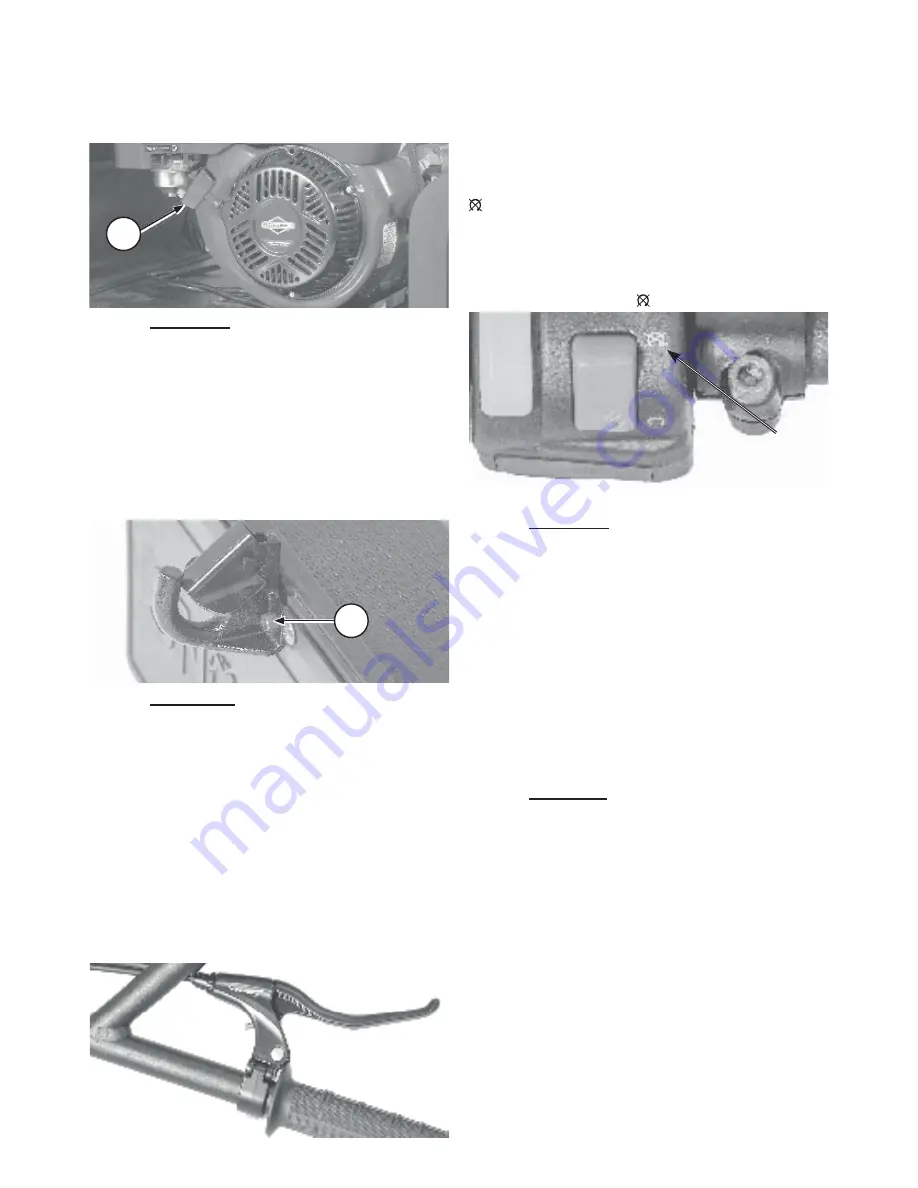
8
5.2 To start the engine with a manual starter pull out the
starter handle (1) until
fi
rst noticeable resistance.
Without returning it to its place, swiftly pull the handle
further out and start the engine. After starting the
engine, slowly return the handle back to its initial
position, allowing for the cord to wind-up.
!
WARNING
Do not twitch the handle when starting. Do
not pull the cord out all the way until it stops.
Do not release starter handle abruptly after
starting.
5.3 After 5 failed attempts to start, pause for at least 30
seconds before the next try.
5.4 Let the engine to run with choke for about a minute,
and then gradually move away the choke. Let the
engine to warm up for at least two minutes.
5.5 Release the parking brake from the
fi
xed position
before moving.
5.6 Check the hooking device and its fastners (1).
!
WARNING!
When operating Snowdog at an ambient
temperature of over 41 °F (+ 5 °C) it is
necessary to open the zipper placed in the
front part of the cover or remove the cover.
Failure to do so will cause the engine to
overheat and will not be covered by warranty.
10 Operating the SNOWDOG
10.1 Operation of the SNOWDOG
SNOWDOG is operated in a standing position. Throttle arm
on the right side of the steering handles controls take-off and
speed change. SNOWDOG starts moving when the throttle arm
is approximately in ¼ position.
Slowly squeeze lever to engage the transmission and to
start the SNOWDOG moving. Increase pressure on the throttle
lever until desired speed is reached.
1
When starting to move on a crumbly snow, accelerate
slowly in order to avoid slipping. To make a turn, steer the
handlebar in the direction opposite to the turn. To stop the
SNOWDOG, release the throttle back — never apply the parking
brake to stop the SNOWDOG while driving.
10.2 Stopping the engine
In case of emergency:
To shut down the engine in case of emergency,
fl
ip the
ignition switch located on the steering switch assembly to “OFF”
position or pull out the engine security switch.
When the SNOWDOG will stop, turn the parking brake on.
In normal cases:
1. Adjust the throttle lever to lower RPMs.
2. Slowly release the throttle lever.
3. Flip the ignition switch located on the steering switch
assembly to “OFF” position.
4. Turn the parking brake on.
!
WARNING
Never use the parking brake to stop the
tracksled. This is dangerous!
5. When stopping for more than 10 minutes close the
fuel petcock (if available).
6. Turn off headlight.
7. Turn off the device, which consume power from the
DC outlet.
When raining or snowing, or the temperature is close to
32 degrees Fahrenheit or lower it is necessary to protect the
SNOWDOG with cover for the time of parking. Otherwise snow
and water can freeze on engine control levers and other parts
of the SNOWDOG making controlling the SNOWDOG impossible.
In case the SNOWDOG was riding through water or wet
snow it is necessary to clear it from snow and ice, otherwise the
water can freeze and bind down the transmission resulting in
inability to move.
Y
CAUTION!
The fi rst 20 hours of operating the SNOWDOG
are needed for engine and transmission
to adjust. During this period you should
use SNOWDOG with lowest possible load.
Prolonged lugging may cause transmission
overload and SNOWDOG failure.
11 Maintenance
11.1 Before each trip
1. Check the secure connection of the parts and
assemblies of the SNOWDOG and tighten the screws
if necessary. Check the parking brake.
2. Check the engine oil level.
3. Check the drive chain, lubricate if necessary.
4. Pay particular attention to handlebar mounting and
attachment of the hitch.
11.2 After each trip
1. Shut down the fuel valve (if provided).
2. Clean SNOWDOG from any snow and/or dirt.
3. Lube the chain with an aerosol chain spray.
4. Visually check the track tension.
1
Summary of Contents for COMPACT B13ME-WR
Page 15: ...15...

















